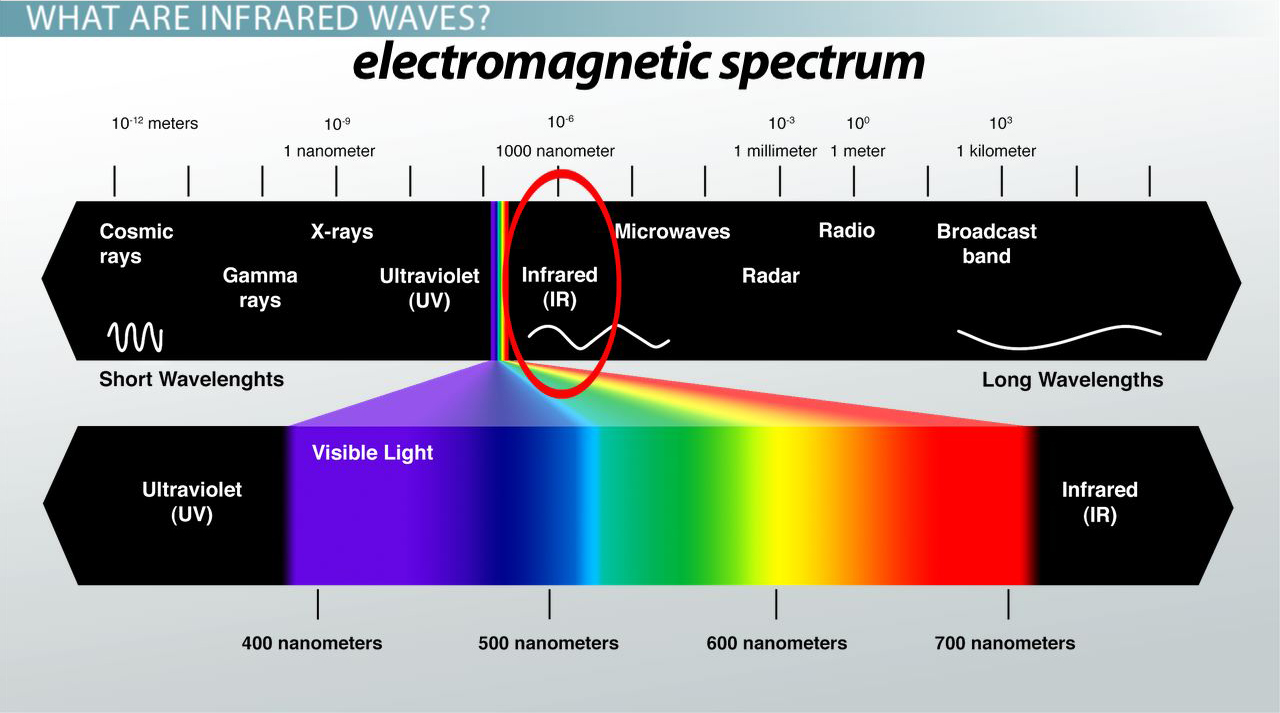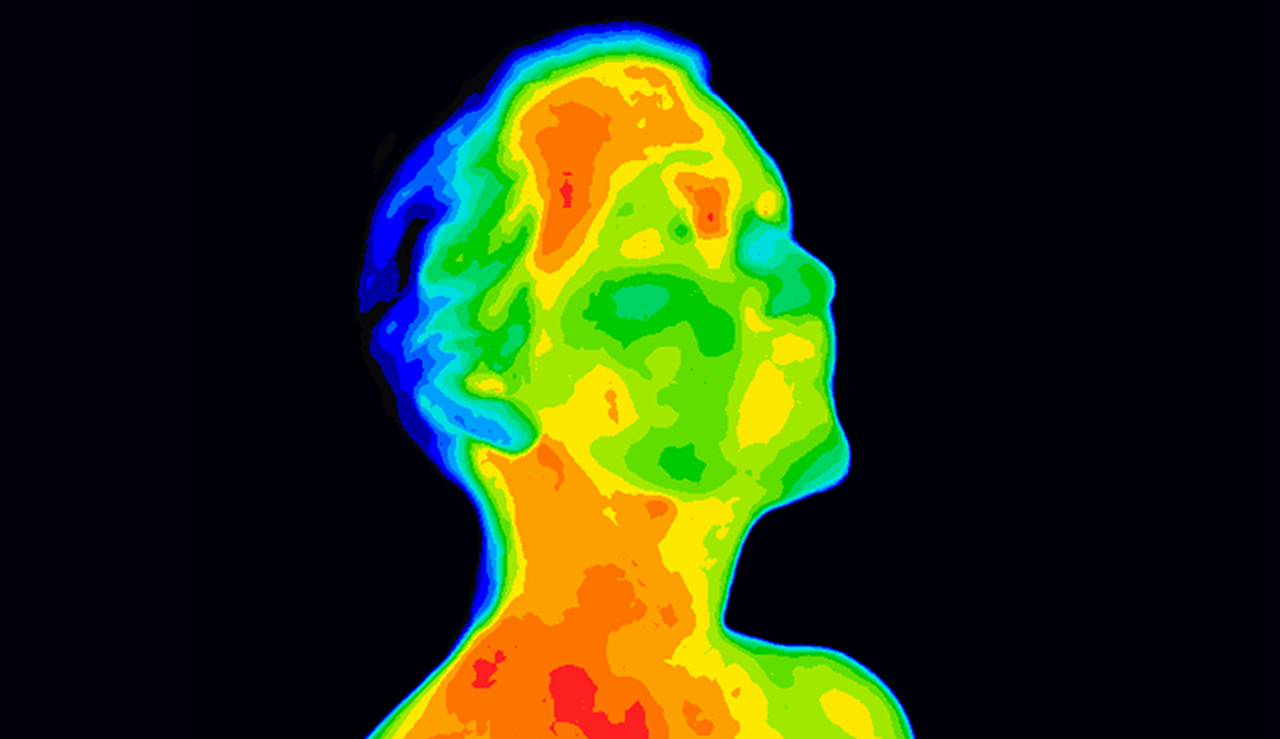To best answer this question we first need to really understand: What exactly is infrared light?
You probably remember in school learning about the electromagnetic spectrum, or perhaps even using a prism to split light into its separate colours, forming a rainbow like effect. This prism of colours is 'visible light', that is, light that human eyes can actually detect. Also on this spectrum sits the light we can't see: ultraviolet light and of course, infrared light.

Although we cannot see infrared light without use of special equipment, we can sense it as heat, hence why it is also referred to as thermal radiation. Any object that has a temperature is emitting some degree of infrared, from humans to the sun.
To understand this you need to think of light as waves of energy. This energy is able to affect the movement of atoms, exciting them to warm them up. More specifically, scientists know that infrared light is able to penetrate our cells and tissues up to an inch and a half deep, heating them with ease. This means that infrared is able to heat out bodies from the inside out as opposed to your typical sauna where bodies are warmed through the air becoming warm which in turn heats our outsides.
In therapeutic treatment, infrared pulses are able to heat water in cells creating a rapid and local increase in temperature which then changes the cell membranes electrical capacity and depolarises the cell. This process is entirely reversible and has some really far ranging clinical applications!

Whilst the sun emits infrared light, visible light and UV-light, infrared lamps exclusively emit infrared light. This means that the problems associated with being in the sun too long (skin damage etc) are not relevant to use of Infrared outdoor heaters. It is true that long and very intense exposure to infrared light has been known to cause damage to the retina, however this is only relevant to people working in occupations such as metal welding and other intensely hot jobs!
In fact, wavelengths are well known for thier therapeutic effects. The photo-stimulatory effects of infrared radiation are often used in lasers and lamps to treat skin conditions, accelerate healing, reduce inflammation and accelerate the metabolism. It is even suggested in the future that bandages and dressings that are able to emit infrared may be designed in order to enhance recovery and subsequent performance of people and sports animals. Modern clothing exists that is designed to emit infrared and has been shown to be successful in pain management, recovery and knee osteoarthritis.

Science suggests that it's not just the heat itself which is providing these therapeutic effects. Infrared heat is thought to alter the function of our cells to some extent. Mitochondria (the powerhouse of all our cells) contain tiny light receptors which are responsive to infrared light and can absorb some of this energy and use it, much like a plant would. Whilst we're no way nearly as efficient as plants at converting light to energy, it can provide people with a much needed boost.
Fringe-like treatments such as infrared saunas are being used more and more frequently in order to improve cardiac function and aid recovery, much like gentle exercise would. The benefit here is that these therapeutic effects are attained without the possible negative effects of exercise such as heart problems, oxidative stress or chronic fatigue.
There's a common misconception that infrared light emits Ozone, however this is scientifically untrue and a completely unfounded claim. Infrared has no known by-products with its only consideration being the electricity you're using to generate it!
Damage that the sun causes to skin is due to visible light and UV light, infrared light has no known cancer-causing properties. In fact, recent studies go so far as to suggest that infrared light in the morning sends our skin a message a message that damaging UV light is on the way and prepares us as an evolutionary adaption. Conversely infrared light is heavily used in medical therapies in order to actually kill cancer cells. This is a really complicated process but essentially patients are injected with a serum that contains tags for the infrared light to sense. These tags are designed to specifically attach to receptors that are only found on cancer cells. Once attached, infrared is pulsed through and effectively destroys any cells that have been tagged.
References:
Shapiro, M., Homma, K., Villarreal, S. et al. Infrared light excites cells by changing their electrical capacitance. Nat Commun 3, 736 (2012). Infrared light
Study.com. 2021. [online] Available at: Infrared waves definition uses examples [Accessed 16 February 2021].
de Freitas, L. and Hamblin, M., 2016. Proposed Mechanisms of Photobiomodulation or Low-Level Light Therapy. IEEE Journal of Selected Topics in Quantum Electronics, 22(3), pp.348-364.
Vatansever, F. and Hamblin, M., 2012. Far infrared radiation (FIR): Its biological effects and medical applications. Photonics & Lasers in Medicine, 1(4).
Barolet, D., Christiaens, F. and Hamblin, M., 2016. Infrared and skin: Friend or foe. Journal of Photochemistry and Photobiology B: Biology, 155, pp.78-85.
National Cancer Institute. 2021. Killing Cancer Cells with the Help of Infrared Light - Photoimmunotherapy. [online] Available at: About cancer photoimmunotherapy video [Accessed 16 February 2021].
Beever R. Far-infrared saunas for treatment of cardiovascular risk factors Summary of published evidence. Canadian family physician. 2009;55(7):691-696
Repeated sauna treatment improves vascular endothelial and cardiac function in patients with chronic heart failure.
Kihara T, Biro S, Imamura M, Yoshifuku S, Takasaki K, Ikeda Y, Otuji Y, Minagoe S, Toyama Y, Tei C
J Am Coll Cardiol. 2002 Mar 6; 39(5):754-9.
Far infrared emitting plaster in knee osteoarthritis: a single blinded, randomised clinical trial.
Bagnato GL, Miceli G, Atteritano M, Marino N, Bagnato GF
Reumatismo. 2012 Dec 20; 64(6):388-94.
Vatansever, F. and Hamblin, M., 2012. Far infrared radiation (FIR): Its biological effects and medical applications. Photonics & Lasers in Medicine, 1(4).
R Hamblin, M., 2017. Mechanisms and applications of the anti-inflammatory effects of photobiomodulation. AIMS Biophysics, 4(3), pp.337-361.
ICNIRP (International Commission on Non-Ionizing Radiation Protection). ICNIRP guidelines on limits of exposure to incoherent visible and infrared radiation. Health Phys. 2010, 105, 74-96.
Sliney, D. What is light? The visible spectrum and beyond. Eye 2016, 30, 222-229.
Crockett, C., 2021. What is the electromagnetic spectrum? | EarthSky.org. [online] Earthsky.org. Available at: What is the electromagnetic spectrum [Accessed 16 February 2021].
livescience.com. 2021. What Is Infrared?. [online] Available at: Infrared radiation [Accessed 16 February 2021].